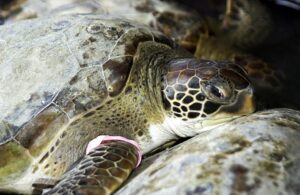The Gulf of Maine’s warming waters have led to increased sea turtle strandings on Cape Cod’s shores. Over 200 cold-stunned young turtles received treatment at the New England Aquarium’s facility on Tuesday, December 3, 2024—a number that reveals concerning shifts in marine ecosystems. In 2010, rescuers treated an average of 40 turtles annually.
The rising numbers paint a stark picture. The National Oceanic and Atmospheric Administration’s data shows stranding events of cold-stunned sea turtles in Massachusetts have risen from a five-year average of 200 in the early 2010s to more than 700 in recent years. The Gulf of Maine stands as one of the ocean’s fastest-warming regions, creating conditions that trap migrating turtles.
“Climate change certainly is allowing those numbers of turtles to get in where normally the numbers weren’t very high years ago,” stated Adam Kennedy, Director of Rescue and Rehabilitation at the New England Aquarium.
Scientific evidence supports these observations. A 2019 PLoS One study linked ocean warming directly to increased cold-stunning events in the Northwest Atlantic. The warmer waters attract turtles northward until Cape Cod’s hook-shaped geography prevents their southward escape when temperatures drop.
At the Quincy, Massachusetts, rehabilitation facility, veterinary teams face mounting challenges. Each turtle requires specific medical interventions. “The majority of the turtles arrive with serious ailments such as pneumonia, dehydration, traumatic injuries, or sepsis,” reported Melissa Joblon, Director of Animal Health at the aquarium. The facility maintains an 80% survival rate, but this success demands intensive care and considerable resources.
The critically endangered Kemp’s ridley turtles form the majority of patients, with green turtles and loggerheads appearing in smaller numbers. Recent high winds and temperature drops have accelerated strandings, necessitating round-the-clock rescue operations.
Mass Audubon volunteers patrol beaches in shifts, coordinating with New England Aquarium rescue teams. Each rescued turtle requires immediate transport, initial medical assessment, and ongoing care—a process that tests the limits of available facilities and personnel.
Current trends suggest cold-stunning events will likely increase. The aquarium expects to treat at least 400 turtles this season, straining rehabilitation resources and raising questions about the long-term sustainability of rescue efforts.
“At the end of the day, getting these turtles back to the wild is what we are doing and what we want,” said Kennedy. “We want them back in the ocean.” The statement underscores the growing challenges facing marine conservation efforts in changing oceanic conditions,” he adds.

















